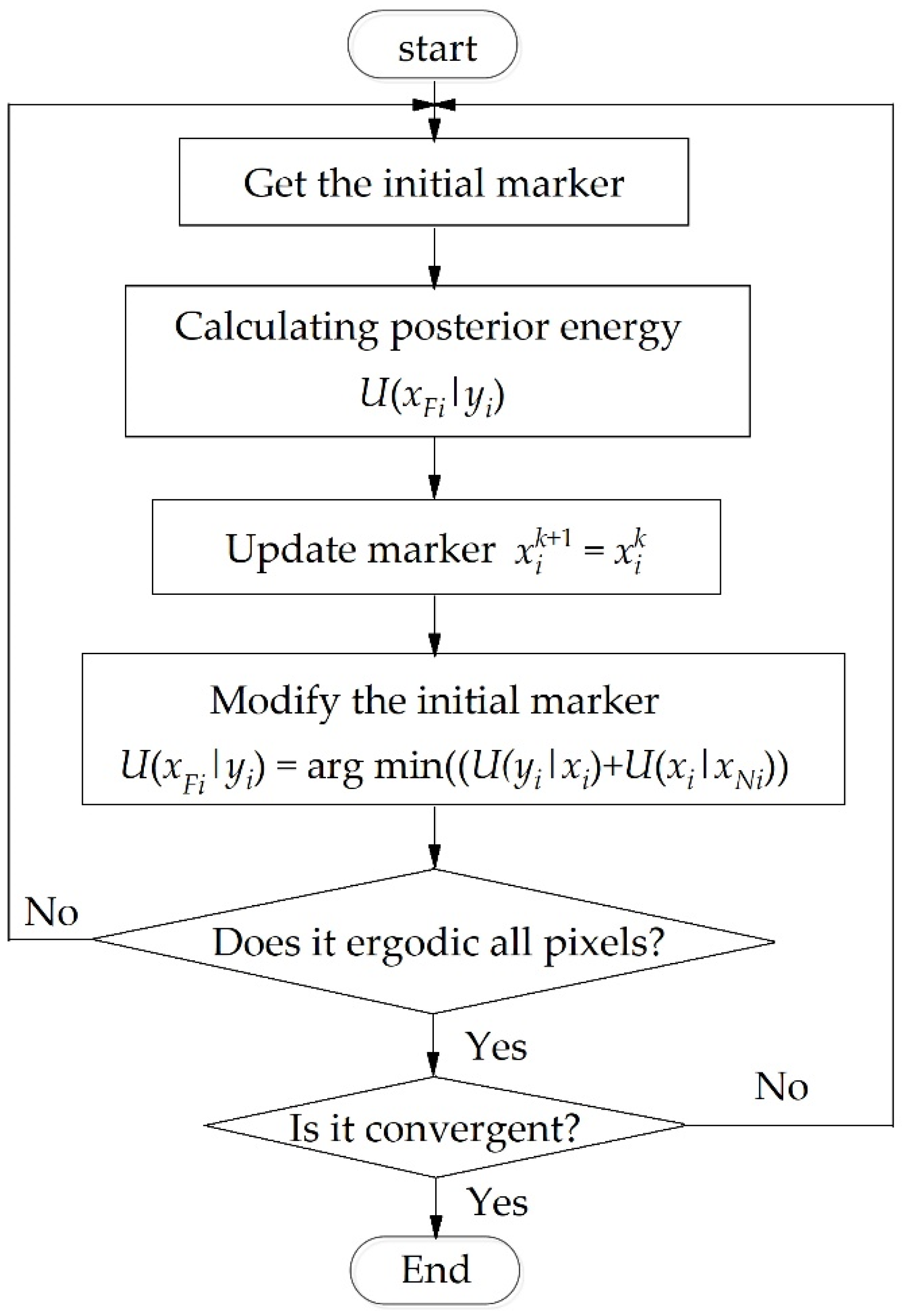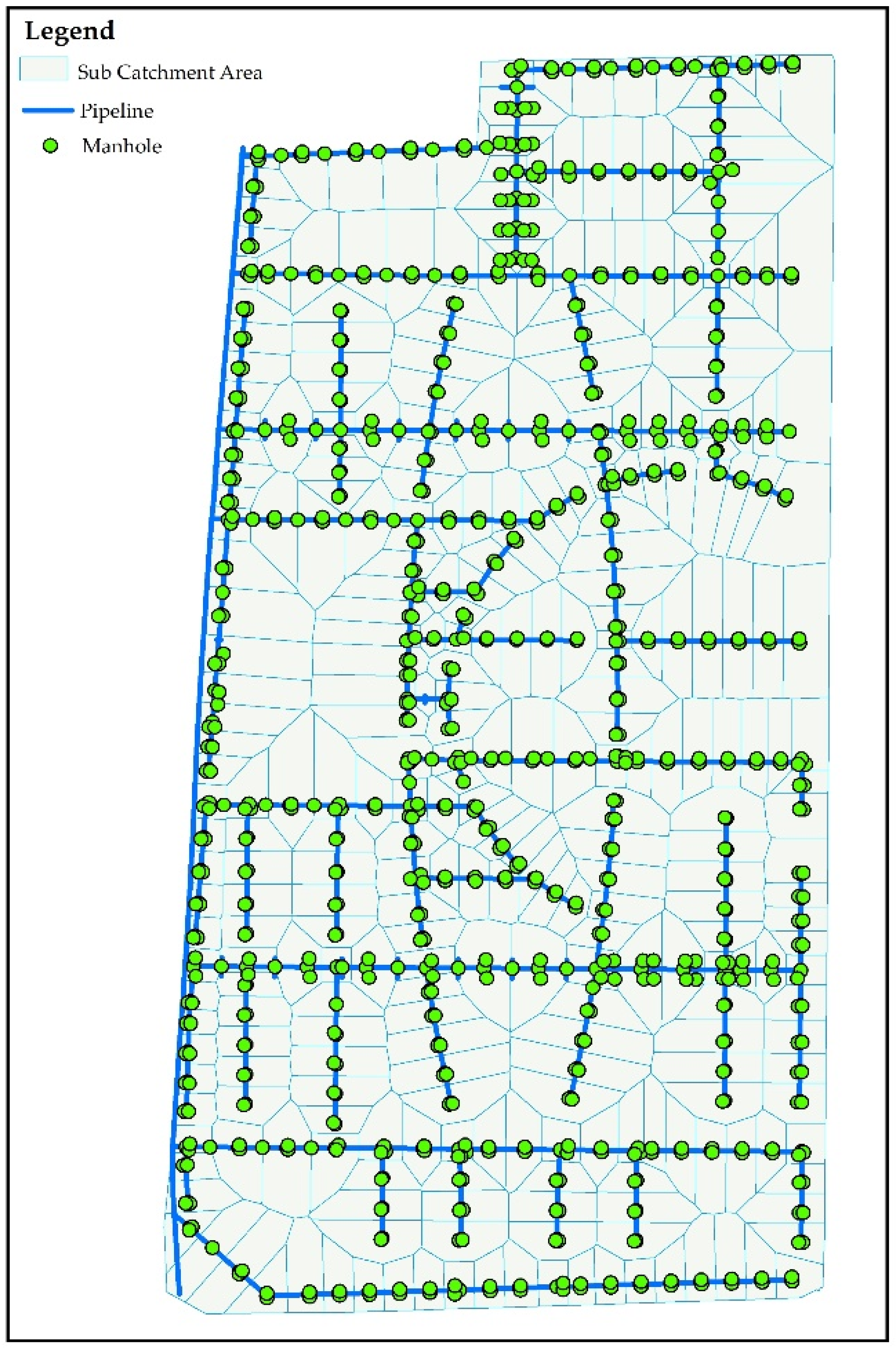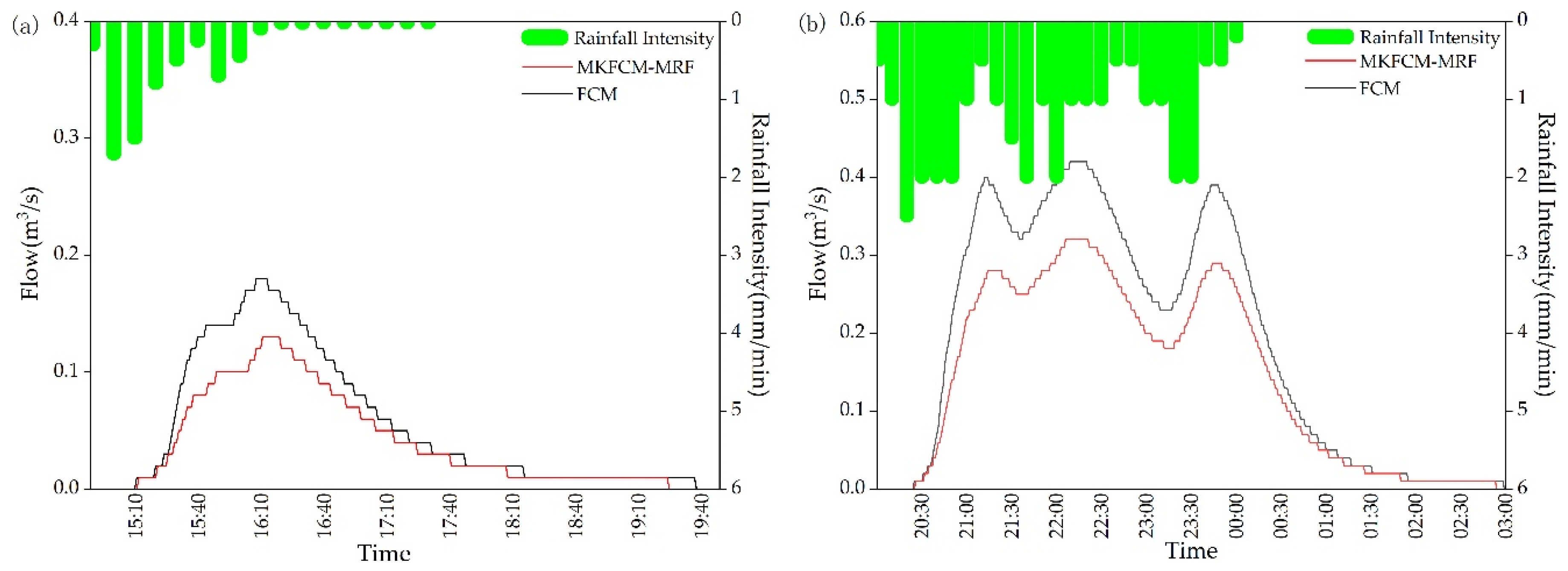Obtaining Land Cover Type for Urban Storm Flood Model in UAV Images Using MRF and MKFCM Clustering Techniques
Abstract
1. Introduction
2. Acquisition and Preprocessing of UAV Images
2.1. Acquisition of UAV Images
2.2. Preprocessing of UAV Images
3. Methods
3.1. Multiple-Kernel Fuzzy C-Means Clustering Algorithm
3.2. Markov Random Field Theory
3.3. Constructing MRF-MKFCM Model Based on MKFCM and MRF
4. Results
5. Discussion
5.1. Accuracy Analysis
5.2. Verification of Urban Storm Flood Model
6. Conclusions
Author Contributions
Funding
Conflicts of Interest
References
- Schubert, J.E.; Sanders, B.F. Building treatments for urban flood inundation models and implications for predictive skill and modeling efficiency. Adv. Water Resour. 2012, 41, 49–64. [Google Scholar] [CrossRef]
- Mignot, E.; Paquier, A.; Haider, S. Modeling floods in a dense urban area using 2D shallow water equations. J. Hydrol. 2006, 327, 186–199. [Google Scholar] [CrossRef]
- Aronica, G.T.; Lanza, L.G. Drainage efficiency in urban areas: A case study. Hydrol. Process. 2010, 19, 1105–1119. [Google Scholar] [CrossRef]
- Wilson, M.D.; Atkinson, P.M. The use of elevation data in flood inundation modelling: A comparison of ERS interferometric SAR and combined contour and differential GPS data. Int. J. River Basin Manag. 2005, 3, 3–20. [Google Scholar] [CrossRef]
- Zainuddin, K.; Jaffri, M.H.; Zainal, M.Z.; Ghazali, N.; Samad, A.M. Verification test on ability to use low-cost UAV for quantifying tree height. In Proceedings of the International Colloquium on Signal Processing & Its Applications, Malacca City, Malaysia, 4–6 March 2016. [Google Scholar]
- Nuguyen, T.; Walker, C.; Walker, E. A First Course in Fuzzy and Neural Control; Chapman & Hall/CRC: Boca Raton, FL, USA, 2003. [Google Scholar]
- Chuang, K.S.; Tzeng, H.L.; Chen, S.; Wu, J.; Chen, T.J. Fuzzy c-means clustering with spatial information for image segmentation. Comput. Med. Imaging Graph. 2006, 30, 9–15. [Google Scholar] [CrossRef]
- Gong, M.; Liang, Y.; Shi, J. Fuzzy C-means clustering with local information and kernel metric for image segmentation. Trans. Image Process. 2012, 22, 573–584. [Google Scholar] [CrossRef]
- Hung, M.C.; Yang, D.L. An efficient fuzzy c-means clustering algorithm. In Proceedings of the IEEE International Conference on Data Mining, San Jose, CA, USA, 29 November–2 December 2001. [Google Scholar]
- Duan, L.; Yu, F.; Zhan, L. An Improved Fuzzy C-means Clustering Algorithm. In Proceedings of the 12th International Conference on Natural Computation, Fuzzy Systems and Knowledge Discovery (ICNC-FSKD), Changsha, China, 13–15 August 2016; pp. 1199–1204. [Google Scholar]
- Mehena, J.; Adhikary, M.C. Medical Image Segmentation and Detection of MR Images Based on Spatial Multiple-Kernel Fuzzy C-Means Algorithm. Int. J. Med. Health Biomed. Bioeng. Pharm. Eng. 2015, 9, 518–522. [Google Scholar]
- Du, G.; Miao, F.; Tian, S.; Liu, Y. A Modified Fuzzy C-means Algorithm in Remote Sensing Image Segmentation. In Proceedings of the International Conference on Environmental Science & Information Application Technology, Wuhan, China, 4–5 July 2009. [Google Scholar]
- Nookala, V.; Anuradha, B. A Novel Multiple-kernel based Fuzzy c-means Algorithm with Spatial Information for Medical Image Segmentation. Int. J. Image Process. 2013, 7, 286–301. [Google Scholar]
- Dhanalakshmi, L.; Ranjitha, S.; Suresh, H.N. Image processing using Modified Multiple kernel fuzzy c-means clustering (MMKFCM) technique. In Proceedings of the 2nd International Conference on Applied and Theoretical Computing and Communication Technology (iCATccT), Bangalore, India, 21–23 July 2016; pp. 641–646. [Google Scholar]
- Nguyen, D.D.; Ngo, L.T. Multiple kernel interval type-2 fuzzy c-means clustering. In Proceedings of the IEEE International Conference on Fuzzy Systems (FUZZ-IEEE), Hyderabad, India, 7–10 July 2013. [Google Scholar]
- Nguyen, D.D.; Ngo, L.T.; Pham, L.T.; Pedrycz, W. Towards hybrid clustering approach to data classification: Multiple kernels based interval-valued Fuzzy C-Means algorithms. Fuzzy Sets Syst. 2015, 279, 17–39. [Google Scholar] [CrossRef]
- Alajlan, N.; Bazi, Y.; Melgani, F.; Yager, R. Fusion of supervised and unsupervised learning for improved classification of hyperspectral images. Inf. Sci. 2012, 217, 39–55. [Google Scholar] [CrossRef]
- Raj, R.J.R. Change detection in SAR based on FCM with modified MRF approach. J. Eng. Appl. Sci. 2017, 12, 7272–7275. [Google Scholar]
- Abdulbaqi, H.S.; Jafri, M.Z.M.; Omar, A.F.; Mustafa, I.S.B.; Abood, L.K. Detecting Brain Tumor in Computed Tomography Images Using Markov Random Fields and Fuzzy C-means Clustering Techniques. In Proceedings of the PERFIK2014, Kuala Lumpur, Malaysia, 18–19 November 2014. [Google Scholar]
- Liu, J.; Lei, Y.; Xing, Y.; Lu, C. Multispectral and panchromatic images fusion using the Markov-random-field-based FCM. Remote Sens. Lett. 2015, 6, 992–1001. [Google Scholar] [CrossRef]
- Chen, L.; Chen, C.L.P.; Lu, M. A Multiple-Kernel Fuzzy C-Means Algorithm for Image Segmentation. IEEE Trans. Syst. Man Cybern.-Part B Cybern. 2011, 41, 1263–1274. [Google Scholar] [CrossRef]
- Liu, S.; Li, X.; Li, Z. A new image segmentation algorithm based the fusion of Markov random field and fuzzy c-means clustering. Proc. ISCIT 2005, 1, 144–147. [Google Scholar]
- Honglei, Y. Remote Sensing Classification Using Fuzzy C-means Clustering with Spatial Constraints Based on Markov Random Field. Eur. J. Remote Sens. 2013, 46, 305–316. [Google Scholar] [CrossRef]
- Zhou, Y.; Zhang, H.; Xu, X.; Li, M.; Zheng, L.; Zhu, Y. A Novel Classification Optimization Approach Integrating Class Adaptive MRF and Fuzzy Local Information for High Spatial Resolution Multispectral Imagery. Appl. Sci. 2018, 8, 1792. [Google Scholar] [CrossRef]
- Binu, D.; Selvi, M.; Aloysius, G. MKF-Cuckoo: Hybridization of Cuckoo Search and Multiple Kernel-Based Fuzzy C-Means Algorithm. AASRI Procedia 2013, 4, 243–249. [Google Scholar] [CrossRef]
- Slonecker, E.T.; Jennings, D.B.; Garofalo, D. Remote sensing of impervious surfaces: A review. Remote Sens. Rev. 2001, 20, 227–255. [Google Scholar] [CrossRef]
- Carlson, T.N.; Traci Arthur, S. The impact of land use-land cover changes due to urbanization on surface microclimate and hydrology: A satellite perspective. Glob. Planet. Chang. 2000, 25, 49–65. [Google Scholar] [CrossRef]
- Graham, P.H.; Costello, L.S.; Mallon, H.J. Estimation of imperviousness and specific curb length for forecasting stormwater quality and quantity. J. Water Pollut. Control Fed. 1974, 46, 717–725. [Google Scholar]
- Montzka, C.; Canty, M.; Kunkel, R.; Menz, G.; Vereecken, H.; Wendland, F. Modelling the water balance of a mesoscale catchment basin using remotely sensed land cover data. J. Hydrol. 2008, 353, 322–334. [Google Scholar] [CrossRef]
- Zhou, Y.; Wang, Y.; Gold, A.J.; August, P.V. Modeling watershed rainfall-runoff relations using impervious surface-area data with high spatial resolution. Hydrogeol. J. 2010, 18, 1413–1423. [Google Scholar] [CrossRef]
- Jorge, G.; Roesner, L.A.; Rossman, L.A. A new applications manual for the Storm Water Management Model (SWMM). Environ. Model. Softw. 2010, 25, 813–814. [Google Scholar]
- Marsalek, J.; Dick, T.M.; Wisner, P.E. Comparative evaluation of three urban runoff MODELS1. J. Am. Water Resour. Assoc. 2010, 11, 306–328. [Google Scholar] [CrossRef]
- Fiddes, D. The TRRL East African flood model. Des. Storm 1976, 16, 111–129. [Google Scholar]
- Terstriep, M.L.; Stall, J.B. The Illinois Urban Drainage Area Simulator, ILLUDAS; Bulletin 58; State of ILLINOIS, Department of Registration and Education: Champaign, IL, USA, 1974. [Google Scholar]
- DHI. MIKE-FLOOD: 1D-2D Modeling User Manual; Danish Hydraulic Institute (DHI): Horsholm, Denmark, 2009. [Google Scholar]
- Van der, S.M.; Rahman, A.; Ryan, G. Modeling of a lot scale rainwater tank system in XP-SWMM: A case study in Western Sydney, Australia. J. Environ. Manag. 2014, 141, 177–189. [Google Scholar] [CrossRef] [PubMed]
- Ma, J.M.; Yu, H.J. Characteristics and Application of Flood Analysis Software IFMS/Urban. China Water Conserv. 2017, 5, 74–76. [Google Scholar]











| Image Elements | Reality Classes | Total Count | User’s Accuracy (%) | |||
|---|---|---|---|---|---|---|
| Water Bodies | Impermeable Lands | Permeable Lands | ||||
| Clustering Classes | Water Bodies | 485,128 | 19 | 243,691 | 7,288,338 | 66.56 |
| Impermeable Lands | 6035 | 285,637 | 90,308 | 381,980 | 74.78 | |
| Permeable Lands | 18,396 | 0 | 376,863 | 395,259 | 95.35 | |
| Total Count | 509,559 | 285,656 | 710,862 | 1,506,077 | ||
| Product’s Accuracy (%) | 95.21 | 99.99 | 53.01 | |||
| Overall Accuracy = 0.76; Kappa Coefficient = 0.64 | ||||||
| Image Elements | Reality Classes | Total Count | User’s Accuracy (%) | |||
|---|---|---|---|---|---|---|
| Water Bodies | Impermeable Lands | Permeable Lands | ||||
| Clustering Classes | Water Bodies | 356,184 | 0 | 3813 | 359,997 | 98.94 |
| Impermeable Lands | 149,973 | 285,297 | 39,132 | 474,402 | 60.13 | |
| Permeable Lands | 3402 | 359 | 667,917 | 671,678 | 99.44 | |
| Total Count | 509,559 | 285,656 | 710,862 | 1,506,077 | ||
| Product’s Accuracy (%) | 69.9 | 99.87 | 93.95 | |||
| Overall Accuracy = 0.87; Kappa Coefficient = 0.80 | ||||||
| Rainfall Date | Clustering Algorithm | Runoff Producing Time | Peak Time | Peak Flow (m3/s) | Total Runoff (m3) |
|---|---|---|---|---|---|
| 12 August 2017 | FCM | 15:12 | 16:12 | 0.18 | 978.946 |
| MKFCM-MRF | 15:13 | 16:13 | 0.13 | 734.464 | |
| 1 August 2018 | FCM | 20:21 | 22:15 | 0.42 | 4703.723 |
| MKFCM-MRF | 20:22 | 22:16 | 0.32 | 3591.477 |
© 2019 by the authors. Licensee MDPI, Basel, Switzerland. This article is an open access article distributed under the terms and conditions of the Creative Commons Attribution (CC BY) license (http://creativecommons.org/licenses/by/4.0/).
Share and Cite
Wang, Y.; Zhang, C.; Zhang, Y.; Huang, H.; Feng, L. Obtaining Land Cover Type for Urban Storm Flood Model in UAV Images Using MRF and MKFCM Clustering Techniques. ISPRS Int. J. Geo-Inf. 2019, 8, 205. https://doi.org/10.3390/ijgi8050205
Wang Y, Zhang C, Zhang Y, Huang H, Feng L. Obtaining Land Cover Type for Urban Storm Flood Model in UAV Images Using MRF and MKFCM Clustering Techniques. ISPRS International Journal of Geo-Information. 2019; 8(5):205. https://doi.org/10.3390/ijgi8050205
Chicago/Turabian StyleWang, Yanmei, Chengcai Zhang, Yisheng Zhang, He Huang, and Lingtong Feng. 2019. "Obtaining Land Cover Type for Urban Storm Flood Model in UAV Images Using MRF and MKFCM Clustering Techniques" ISPRS International Journal of Geo-Information 8, no. 5: 205. https://doi.org/10.3390/ijgi8050205
APA StyleWang, Y., Zhang, C., Zhang, Y., Huang, H., & Feng, L. (2019). Obtaining Land Cover Type for Urban Storm Flood Model in UAV Images Using MRF and MKFCM Clustering Techniques. ISPRS International Journal of Geo-Information, 8(5), 205. https://doi.org/10.3390/ijgi8050205






